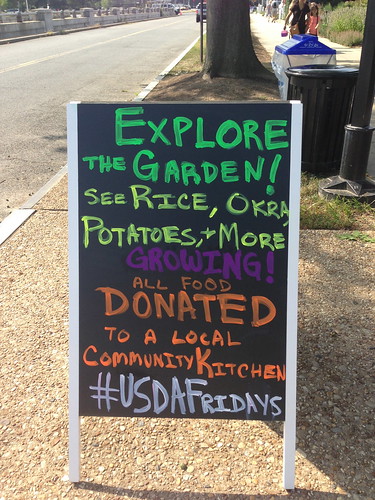
All summer, visitors to the National Capitol Region have been seeing monuments, public buildings, works of art and experiencing music and theater; however, many were unexpectedly surprised by the brilliant hues of purple, red and green emanating from USDA’s People’s Garden.
But those colors didn’t just pop up on their own. USDA has a cadre of friendly and knowledgeable employee volunteers who plant, maintain and harvest as well as interact and answer questions from hundreds of people who stop by to admire the garden.
“People need to have a connection to their food, like I did when I was growing up,” said Lee Cliburn, who works for the USDA’s Agricultural Marketing Service (AMS) - the agency that manages the People’s Garden. Cliburn is one of several USDA Master Gardeners who harvests vegetables on Tuesdays and Fridays. “My grandmother was a talented and skillful gardener, and I learned from her.”
Many of the homegrown and overseas folks who stop by the organic vegetable garden at the intersection of Jefferson Drive and 12th Street, SW (northeast corner of USDA Headquarters property) have previously gardened or currently have a garden at home. Some have never experienced the joy and satisfaction of growing anything.
“Kids visit us, see the garden and the projects we’re working on, and ask questions. This is an important project because it reconnects USDA with the people it serves and gets them thinking about their food,” said Cliburn.
Yet, this People’s Garden provides much more than a learning environment for tourists and spectators. Each week, hundreds of pounds of vegetables and herbs are harvested and donated to DC Central Kitchen (DCCK), where it is prepared and provided to folks who need help putting food on their tables.
“They’re so appreciative,” said Tanya Brown, who works for the Farm Service Agency and drives the produce to DCCK. “They get green food, healthy food and herbs like basil and sage. When I walk in they all say ‘Here comes the herb lady.’”
DCCK provides 5,000 meals to 100 homeless shelters, transitional homes and nonprofit organizations throughout The District. Brown said the donated vegetables are used to help prepare some of these meals and when DCCK makes its menu, they say it comes from the People’s Garden.
By the simple act of planting a garden and having volunteers care for it has provided an outlet that not only educates the community but provides a solution to hunger.
“Having the benefit of fresh vegetables and the experience of gardening encourages me to promote this basic human right for everyone,” said Effie Baldwin, who works for the National Institute of Food and Agriculture and also harvests vegetables on Tuesdays and Fridays. “Spending time in USDA’s People’s Garden not only provides a service but brings back memories of Midwestern summer days spent in my grandparent’s backyard garden.”
That’s the sentiment of many USDA Executive Master Gardeners who volunteer with the People’s Garden. Whether it’s listening to a visitor’s gardening woes, answering questions about a vegetable or plant, or donating food to feed the homeless, gardening is more than just food — it’s a labor of love.
Want to volunteer at your local People’s Garden? You can find a People’s Garden in your neighborhood on our interactive map. There are 2,116 gardens – located in all 50 states, three U.S. territories and twelve foreign countries – registered as People’s Garden.

